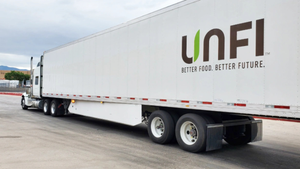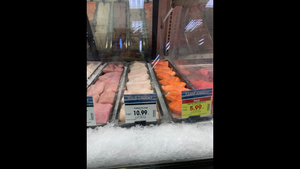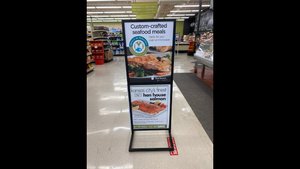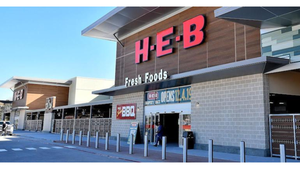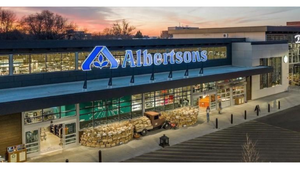The Cool Factor
By getting onboard with mobile marketing, social media and interactive websites, retailers are cultivating a sophisticated image attractive to tech-savvy consumers
November 1, 2010
MICHAEL GARRY
“Cool” is the watchword of the new generation of tech-savvy consumers. An app may be cool. The latest smart phone may be cool. Same with Twitter. But what about food shopping?
Food shopping, of course, usually falls within the realm of prosaic necessity, hardly cool. But as the worlds of consumer technology and retailing continue to intersect through the Web, social media and smart phones, retailers are increasingly trying to tap these technologies, not just for their practical value, but for the sophisticated and au courant image they confer.

Bill Nasshan
For example, Bi-Lo, Greenville, S.C., felt that it needed an image makeover to compete better with chains like Publix and Harris Teeter, observed Bill Nasshan, Bi-Lo's senior vice president of marketing and merchandising. “For years we went with ‘Bi-Lo, the name says it all,’” he said during a panel discussion on mobile marketing at the LEAD Marketing Conference, held last month in Rosemont, Ill., by the Shopper Technology Institute. “But that's not what's relevant to customers today.” What Bi-Lo needed, he added, was “the cool factor.” But how to get it?
One way is to have “the right approach” to mobile marketing, Nasshan said. “As long as we deliver fresh stores and great service and relevant offers, this can be that cool factor that helps us get a little more loyalty from our customers.” So Bi-Lo assigned a management-level executive in its marketing group to develop strategies for mobile applications.
Other food retailers are also devoting resources to consumer-oriented technologies. For example, Supervalu has created a social media task force at its Minneapolis headquarters to support the Facebook initiatives at its various retail brands, among other efforts. “We're playing with Facebook and dabbling in Twitter, and we've done tests in Foursquare,” said Shelly Nelson, director of connections strategy and media for Supervalu, who participated in a social media panel discussion at the LEAD Marketing Conference.
Supervalu's philosophy with social media is to “experience things, fail often and fail fast,” Nelson said. “You can experiment, get your feet wet and see what you can do in a fairly inexpensive manner, except for people time.”
Some chains are focusing on upgrading their websites to bring the latest interactive tools to shoppers. This year Hannaford Bros., Scarborough, Maine, redesigned its website, www.hannaford.com, for that purpose. “We want the platform to create stronger connections with shoppers,” said Mark Bradeen, Hannaford's manager of promotions and online loyalty. “We want customers to have some sense they are personalizing it and have ownership of it.” Shoppers can now use the site to send shopping lists to their mobile phones, create profiles to alert them of allergens in products, and tie products in ads and recipes to their shopping lists.
But as retailers seek the cachet of new technologies, consultant and store owner Gary Hawkins has some caveats for them. “What we are seeing is too many retailers pursuing a lot of channels to the customer - Facebook, Twitter, Foursquare, etc. - without a comprehensive understanding of strategy or knowing where they are going with it,” said Hawkins, president, Center for Advancing Retail & Technology (CART), and chief executive officer of Green Hills, a one-store independent in Syracuse, N.Y., during the LEAD Marketing Conference.
Hawkins also warns that to use digital technologies effectively, retailers need an underpinning of customer-identified transaction data gathered via loyalty programs. Without this data, retailers “know who their customers are online, in email, on Facebooks and Twitter, but they don't know what those customers are purchasing in the store — they can't close the loop,” he said. “They might be spending all of this time communicating to [cherry-pickers] they don't want in their store.”
GO GAMECOCKS!
Mobile phone applications in the retail sphere have so far included coupon dissemination, location-based services, product locators, scanning QR codes and text ads. Bi-Lo, which operates 200 stores in the Southeast and is four months out of bankruptcy, has so far tried sending text messages and some coupon offers to shoppers with smart phones.
Text messages “are not the sexiest of all the things we can execute, but it is the one with the broadest reach,” noted Carol Lauer, principal, Interscope, Westport, Conn., who spoke at the LEAD Marketing Conference. “All phones can take SMS text messages. It can be a very effective, customized way of interacting with shoppers.”
A football-themed text-message promotion directed to 6,000 Bi-Lo shoppers in the Columbia, S.C., market last month prompted 38% to open the message, said Nasshan.
The text message, sent to shoppers who had opted in to receive such communications, focused on an upcoming University of South Carolina Gamecocks football game, a topic of intense interest to many shoppers. “It reminded them of five ways to have a tailgate or house party for the big game and picked key feature items and said Bi-Lo can make that happen,” said Nasshan. “It was just a timely reminder relevant to the customer base.” The success of the text promotion underscored that “relevancy is what's critical” to a successful mobile promotion — “more than just sending out a blanket coupon offer.”
K-VA-T Food Stores is another retailer that sends text messages about college football to shoppers.
Nasshan also believes in the importance of having shoppers opt-in to receive mobile communications. “They [don't mind] if you communicate three times a week because they opted in. They have said we want to know what you can help us with. The fear of communicating too often then comes off the plate.”
This point was validated by a test Bi-Lo conducted in the Chattanooga, Tenn., market, where it has a 40% market share. The test, in which the chain texted a coupon offer to shoppers who had not opted to receive messages, only elicited a 4% to 5% open rate among recipients. He said the chain plans to send coupon offers to opt-in shoppers in the future.
“There are ways to communicate with folks who have not opted in if you make sure it's absolutely relevant,” he said. “This is the immediate gratification generation — you better be relevant or they'll shut you down.”
Bi-Lo reminds shoppers of the opportunity to receive mobile messages in ads, at checkstands and on employee badges. Promising to send shoppers coupons is also “a good way to get people to opt in,” Nasshan said. Bi-Lo also plans to take advantage of its highly popular “fuelperks” program, in which shoppers get a 5-cent discount off the price of a gallon of gas for every $50 they spend at Bi-Lo. For opting in to the mobile program, Bi-Lo shoppers will on occasion receive notices of a fuelperks promotion that doubles their rewards.
Bi-Lo is also developing a mobile app that shoppers will be able to download. “The Holy Grail is the app approach,” said Nasshan. “You open the Bi-Lo app and get coupons and relevant offers based on your loyalty card.”
Last month, Roche Bros., Wellesley Hills, Mass., announced a weekly circular app for the iPhone that offers automatically updated pricing information on store specials and a shopping list capability including product photos.
Nasshan acknowledged the risk of being over-redeemed in a mobile couponing program. “As we make this more about manufacturer participation than our own offers, we will sit down with the manufacturers and talk about potential liabilities and see if we can't put measures in place so we're both protected,” he said. Bi-Lo currently uses purchase requirements to prevent an over-redemption problem in its fuelperks program.
A BLANK SLATE
In its exploration of social media, Supervalu is still debating how far to go with Twitter. “Do you have an Albertsons' Twitter page, or do you have Twitter for every store, every store director, every department manager?” Nelson said. “Do they want to hear from our CEO? We're trying to decide based on what consumers want to hear about.”
Supervalu is also in the early stages with Facebook. All of its 12 banners have a Facebook presence but the only banners with active pages are Albertsons, Jewel and Save-A-Lot. “A lot of it was getting this up and running and seeing what people would post,” she said. “It's a great way to interact with customers. I encourage people in our company to read what customers do and don't like about our stores.”
Also speaking at the LEAD Marketing Conference, James Tenser, owner of VSN Strategies and a retail business consultant based in Tucson, Ariz., said it's too early to know what kind of genuine value social media is bringing to organizations. “I look at these platforms as a blank slate,” he said. “We're scratching the surface at this stage.” At the same time, he added, social media “is inventing a group of shoppers who are ready to interact in a way that wasn't possible even three years ago.”
Facebook allowed Supervalu to try a spinning-wheel game promotion on its Albertsons page that it would not have done in its conventional ads. In addition to helping Supervalu understand some of the technical issues involved in enabling all sorts of Web browsers, the game proved successful with shoppers, doubling the number of fans to 50,000. “It was fun to see the live feedback,” Nelson said. “People were excited about winning $25 gift cards.”
Social media is providing the kind of feedback that the Internet in general is unable to offer. When Supervalu has looked across the Internet — outside of social media — for comments about its retail brands, the company tends to just find talk about price and discounts. “There wasn't a lot of feedback about whether our brand was doing well or not,” Nelson said. “But we definitely see that on Facebook.” Though 50,000 fans on Facebook may be a relatively small sample of Supervalu's customer base, “directionally, it might be indicative of an issue.”
Supervalu has not yet formally used social media input in its consumer research efforts. “It's still in its infancy and we're still trying to drag our research folks to the table,” she said. But the company plans to incorporate social media “into the greater picture to help us make business decisions moving forward.”
Nelson speculated that Supervalu may try to quantify Facebook feedback into positive and negative groups. Another possibility is linking Facebook shoppers to loyalty cards. But at this early stage she does not believe in attaching an ROI calculation to this area, and advised treading carefully with these consumers. “Intuitively, it feels like the right place to talk with customers,” she said. “If we just do that, we're winning.”
As a social media executive, Nelson acknowledged that she is among the many shoppers who resort to Facebook or Twitter if they have a complaint about a company. “But is that a bad thing?” she said. “If a consumer has a complaint, don't you want to hear about it and help them?”
To that end, Supervalu recently assigned call center employees to monitor the Facebook pages of some of its retail banners and respond to queries and complaints as soon as they can, she said.
“They make sure that these get directed to the right people at the company who can answer the questions,” said Nelson.
INTERACTIVE SHOPPING LIST
At Hannaford Bros., an interactive website remains “the centerpiece of our digital strategy,” complementing email, social media, mobile marketing, ecommerce and search functions, said Bradeen. “We're trying to provide store-specific, product-specific content and value through coupons and targeted promotions.” The site was designed by Fry, Ann Arbor, Mich., a subsidiary of Micros Systems.
The shopping list is a key component of Hannaford's redesigned site, which was launched in June. More than half of shoppers make a list before they go food shopping and “we wanted to provide them with almost an extension of the store as they were making their list,” said Bradeen.
Icons next to products indicate whether they are new or promoted, and the site tells shoppers if an item on the list has an allergen they indicated in their profile. Shoppers can also select a nutritional profile, as well as a main and alternative store; if they shop at the latter, the site will tell them whether a product on their list is available there.
Shoppers can populate their list with items in the weekly circular, selecting specific products or general varieties, with items in a recipe and with items featured in manufacturer coupons. The list is sorted by the department layout in the store, and can be emailed, printed or made available on a smart phone, where it can be accessed at Hannaford.com/mobile. Some stores offer online ordering of cakes and deli platters for pick-up in-store.
Email is another important part of Hannaford's digital strategy. The chain sends out its Sunday flier by email on Saturday so that shoppers making a list on Saturday for the next day can incorporate Sunday's pricing.
The interactive features have attracted more shoppers to the site, boosting unique visits by 30% in July and August, said Bradeen. “We see this helping our other digital programs. It's a strong foundation to build on.”
About the Author
You May Also Like


